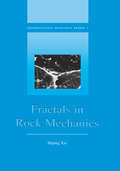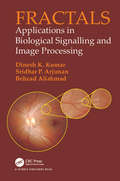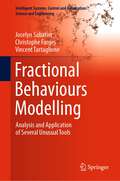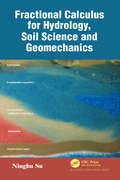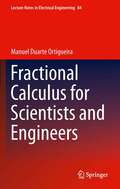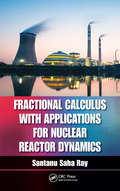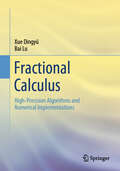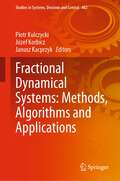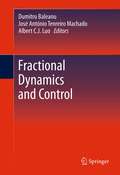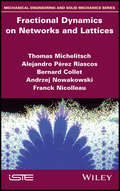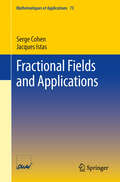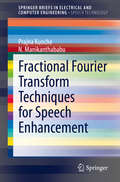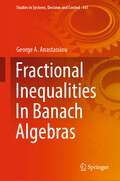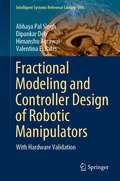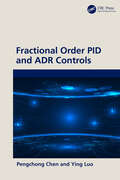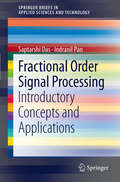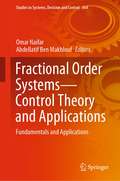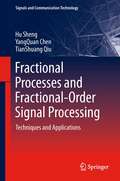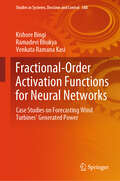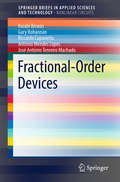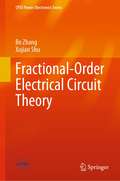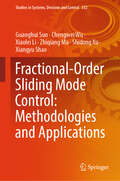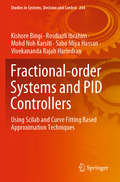- Table View
- List View
Fractals in Rock Mechanics (Geomechanics Research Ser. #1)
by Heping XieImportant developments in the progress of the theory of rock mechanics during recent years are based on fractals and damage mechanics. The concept of fractals has proved to be a useful way of describing the statistics of naturally occurring geometrics. Natural objects, from mountains and coastlines to clouds and forests, are found to have boundaries best described as fractals. Fluid flow through jointed rock masses and clusterings of earthquakes are found to follow fractal patterns in time and space. Fracturing in rocks at all scales, from the microscale (microcracks) to the continental scale (megafaults), can lead to fractal structures. The process of diagenesis and pore geometry of sedimentary rock can be quantitatively described by fractals, etc.The book is mainly concerned with these developments, as related to fractal descriptions of fragmentations, damage and fracture of rocks, rock burst, joint roughness, rock porosity and permeability, rock grain growth, rock and soil particles, shear slips, fluid flow through jointed rocks, faults, earthquake clustering, and so on. The prime concerns of the book are to give a simple account of the basic concepts, methods of fractal geometry, and their applications to rock mechanics, geology, and seismology, and also to discuss damage mechanics of rocks and its application to mining engineering.The book can be used as a textbook for graduate students, by university teachers to prepare courses and seminars, and by active scientists who want to become familiar with a fascinating new field.
Fractals: Applications in Biological Signalling and Image Processing
by Dinesh Kumar Sridhar P. Arjunan Behzad AliahmadThe book provides an insight into the advantages and limitations of the use of fractals in biomedical data. It begins with a brief introduction to the concept of fractals and other associated measures and describes applications for biomedical signals and images. Properties of biological data in relations to fractals and entropy, and the association with health and ageing are also covered. The book provides a detailed description of new techniques on physiological signals and images based on the fractal and chaos theory. The aim of this book is to serve as a comprehensive guide for researchers and readers interested in biomedical signal and image processing and feature extraction for disease risk analyses and rehabilitation applications. While it provides the mathematical rigor for those readers interested in such details, it also describes the topic intuitively such that it is suitable for audience who are interested in applying the methods to healthcare and clinical applications. The book is the outcome of years of research by the authors and is comprehensive and includes other reported outcomes.
Fractional Behaviours Modelling: Analysis and Application of Several Unusual Tools (Intelligent Systems, Control and Automation: Science and Engineering #101)
by Jocelyn Sabatier Christophe Farges Vincent TartaglioneThis book is dedicated to the analysis and modelling of fractional behaviours that mainly result from physical stochastic phenomena (diffusion, adsorption or aggregation, etc.) of a population (ions, molecules, people, etc.) in a constrained environment and that can be found in numerous areas. It breaks with the usual approaches based on fractional models since it proposes to use unusual models which have the advantage of overcoming some of the limitations of fractional models. This book is dedicated to postgraduated students and to researchers in the field or those who wish to learn with a fresh perspective. After a review of fractional models and their limitations, it proposes and demonstrates the interest of four other modelling tools to capture fractional behaviours: new kernels in integral operators, Volterra equations, nonlinear models and partial differential equations with spatially variable coefficients. Several applications on real data and devices illustrate their efficiency.
Fractional Calculus for Hydrology, Soil Science and Geomechanics: An Introduction to Applications
by Ninghu SuThis book is an unique integrated treatise, on the concepts of fractional calculus as models with applications in hydrology, soil science and geomechanics. The models are primarily fractional partial differential equations (fPDEs), and in limited cases, fractional differential equations (fDEs). It develops and applies relevant fPDEs and fDEs mainly to water flow and solute transport in porous media and overland, and in some cases, to concurrent flow and energy transfer. It is an integrated resource with theory and applications for those interested in hydrology, hydraulics and fluid mechanics. The self-contained book summaries the fundamentals for porous media and essential mathematics with extensive references supporting the development of the model and applications.
Fractional Calculus for Scientists and Engineers
by Manuel Duarte OrtigueiraThis book gives a practical overview of Fractional Calculus as it relates to Signal Processing
Fractional Calculus in Medical and Health Science (Mathematics and its Applications)
by Devendra Kumar Jagdev SinghThis book covers applications of fractional calculus used for medical and health science. It offers a collection of research articles built into chapters on classical and modern dynamical systems formulated by fractional differential equations describing human diseases and how to control them. The mathematical results included in the book will be helpful to mathematicians and doctors by enabling them to explain real-life problems accurately. The book will also offer case studies of real-life situations with an emphasis on describing the mathematical results and showing how to apply the results to medical and health science, and at the same time highlighting modeling strategies. The book will be useful to graduate level students, educators and researchers interested in mathematics and medical science.
Fractional Calculus with Applications for Nuclear Reactor Dynamics
by Santanu Saha RayIntroduces Novel Applications for Solving Neutron Transport EquationsWhile deemed nonessential in the past, fractional calculus is now gaining momentum in the science and engineering community. Various disciplines have discovered that realistic models of physical phenomenon can be achieved with fractional calculus and are using them in numerous way
Fractional Calculus: High-Precision Algorithms and Numerical Implementations
by Dingyü Xue Lu BaiFractional calculus and its applications are fascinating research areas in many engineering disciplines. This book is a comprehensive collection of research from the author's group, which is one of the most active in the fractional calculus community worldwide and is the birthplace of one of the four MATLAB toolboxes in fractional calculus, the FOTF Toolbox. The book presents high-precision solution algorithms for a variety of fractional-order differential equations, including nonlinear, delay, and boundary value equations. Currently, there are no other universal solvers available for the latter two types of equations. Through this book, readers can systematically study the mathematics and solution methods in the field of fractional calculus and apply these concepts to different engineering fields, particularly control systems engineering.This book is a translation of an original German edition. The translation was done with the help of artificial intelligence (machine translation by the service DeepL.com). A subsequent human revision was done primarily in terms of content, so that the book will read stylistically differently from a conventional translation.
Fractional Dynamical Systems: Methods, Algorithms and Applications (Studies in Systems, Decision and Control #402)
by Janusz Kacprzyk Piotr Kulczycki Józef KorbiczThis book presents a wide and comprehensive spectrum of issues and problems related to fractional-order dynamical systems. It is meant to be a full-fledge, comprehensive presentation of many aspects related to the broadly perceived fractional-order dynamical systems which constitute an extension of the traditional integer-order-type descriptions. This implies far-reaching consequences, both analytic and algorithmic, because—in general—properties of the traditional integer-order systems cannot be directly extended by a straightforward generalization to fractional-order systems, modeled by fractional-order differential equations involving derivatives of an non-integer order. This can be useful for describing and analyzing, for instance, anomalies in the behavior of various systems, chaotic behavior, etc. The book contains both analytic contributions with state-of-the-art and theoretical foundations, algorithmic implementation of tools and techniques, and—finally—some examples of relevant and successful practical applications.
Fractional Dynamics and Control
by Albert C. Luo José António Machado Dumitru BaleanuFractional Dynamics and Control provides a comprehensive overview of recent advances in the areas of nonlinear dynamics, vibration and control with analytical, numerical, and experimental results. This book provides an overview of recent discoveries in fractional control, delves into fractional variational principles and differential equations, and applies advanced techniques in fractional calculus to solving complicated mathematical and physical problems.Finally, this book also discusses the role that fractional order modeling can play in complex systems for engineering and science.
Fractional Dynamics on Networks and Lattices
by Bernard Collet Thomas Michelitsch Alejandro Perez Riascos Andrzej Nowakowski Franck NicolleauThis book analyzes stochastic processes on networks and regular structures such as lattices by employing the Markovian random walk approach. Part 1 is devoted to the study of local and non-local random walks. It shows how non-local random walk strategies can be defined by functions of the Laplacian matrix that maintain the stochasticity of the transition probabilities. A major result is that only two types of functions are admissible: type (i) functions generate asymptotically local walks with the emergence of Brownian motion, whereas type (ii) functions generate asymptotically scale-free non-local “fractional” walks with the emergence of Lévy flights. In Part 2, fractional dynamics and Lévy flight behavior are analyzed thoroughly, and a generalization of Pólya's classical recurrence theorem is developed for fractional walks. The authors analyze primary fractional walk characteristics such as the mean occupation time, the mean first passage time, the fractal scaling of the set of distinct nodes visited, etc. The results show the improved search capacities of fractional dynamics on networks.
Fractional Fields and Applications
by Serge Cohen Jacques IstasThis book focuses mainly on fractional Brownian fields and their extensions. It has been used to teach graduate students at Grenoble and Toulouse's Universities. It is as self-contained as possible and contains numerous exercises, with solutions in an appendix. After a foreword by Stéphane Jaffard, a long first chapter is devoted to classical results from stochastic fields and fractal analysis. A central notion throughout this book is self-similarity, which is dealt with in a second chapter with a particular emphasis on the celebrated Gaussian self-similar fields, called fractional Brownian fields after Mandelbrot and Van Ness's seminal paper. Fundamental properties of fractional Brownian fields are then stated and proved. The second central notion of this book is the so-called local asymptotic self-similarity (in short lass), which is a local version of self-similarity, defined in the third chapter. A lengthy study is devoted to lass fields with finite variance. Among these lass fields, we find both Gaussian fields and non-Gaussian fields, called Lévy fields. The Lévy fields can be viewed as bridges between fractional Brownian fields and stable self-similar fields. A further key issue concerns the identification of fractional parameters. This is the raison d'être of the statistics chapter, where generalized quadratic variations methods are mainly used for estimating fractional parameters. Last but not least, the simulation is addressed in the last chapter. Unlike the previous issues, the simulation of fractional fields is still an area of ongoing research. The algorithms presented in this chapter are efficient but do not claim to close the debate.
Fractional Fourier Transform Techniques for Speech Enhancement (SpringerBriefs in Speech Technology)
by Prajna Kunche N. ManikanthababuThis book explains speech enhancement in the Fractional Fourier Transform (FRFT) domain and investigates the use of different FRFT algorithms in both single channel and multi-channel enhancement systems, which has proven to be an ideal time frequency analysis tool in many speech signal processing applications. The authors discuss the complexities involved in the highly non- stationary signal processing and the concepts of FRFT for speech enhancement applications. The book explains the fundamentals of FRFT as well as its implementation in speech enhancement. Theories of different FRFT methods are also discussed. The book lets readers understand the new fractional domains to prepare them to develop new algorithms. A comprehensive literature survey regarding the topic is also made available to the reader.
Fractional Inequalities In Banach Algebras (Studies in Systems, Decision and Control #441)
by George A. AnastassiouThis book presents generalized Caputo fractional Ostrowski and Grüss-type inequalities involving several Banach algebra valued functions. Furthermore, the author gives generalized Canavati fractional Ostrowski, Opial, Grüss, and Hilbert-Pachpatte-type inequalities for multiple Banach algebra valued functions. By applying the p-Schatten norms over the von Neumann–Schatten classes, the author produces the analogous refined and interesting inequalities. The author provides many applications. This book’s results are expected to find applications in many areas of pure and applied mathematics, especially in fractional inequalities and fractional differential equations. Other interesting applications are in applied sciences like geophysics, physics, chemistry, economics, and engineering. This book is appropriate for researchers, graduate students, practitioners, and seminars of the above disciplines, also to be in all science and engineering libraries.
Fractional Modeling and Controller Design of Robotic Manipulators: With Hardware Validation (Intelligent Systems Reference Library #194)
by Valentina E. Balas Dipankar Deb Abhaya Pal Singh Himanshu AgrawalThis book at hand is an appropriate addition to the field of fractional calculus applied to control systems. If an engineer or a researcher wishes to delve into fractional-order systems, then this book has many collections of such systems to work upon, and this book also tells the reader about how one can convert an integer-order system into an appropriate fractional-order one through an efficient and simple algorithm. If the reader further wants to explore the controller design for the fractional-order systems, then for them, this book provides a variety of controller design strategies. The use of fractional-order derivatives and integrals in control theory leads to better results than integer-order approaches and hence provides solid motivation for further development of control theory. Fractional-order models are more useful than the integer-order models when accuracy is of paramount importance. Real-time experimental validation of controller design strategies for the fractional-order plants is available. This book is beneficial to the academic institutes for postgraduate and advanced research-level that need a specific textbook on fractional control and its applications in srobotic manipulators. The book is also a valuable teaching and learning resource for undergraduate and postgraduate students.
Fractional Order PID and ADR Controls
by Ying Luo Pengchong ChenThis book explores the design and analysis of fractional-order and active disturbance rejection control, examining both the theoretical foundations and their practical applications.It covers fractional-order proportional-integral-derivative (PID) control, fractional-order active disturbance rejection (ADR) control, and the combined fractional-order PID-ADR control. The book begins with an analysis of the three-parameter fractional-order PID controller, demonstrating its application to the permanent magnet synchronous motor (PMSM) speed servo system, due to its comprehensive inclusion of proportional, integral, and differential elements. It then delves into active disturbance rejection control and periodic disturbance compensation, comparing the performance of each controller based on various parameters. This comparison enables readers to critically evaluate the advantages and limitations of each approach before implementation. Offering a thorough guide to fractional-order and active disturbance rejection control, the book also includes numerical methods for assessing and developing these systems.The book will be of particular interest to professionals working with numerical methods, fractional-order systems and control, PID controller, active disturbance rejection, control design, and production and is especially relevant to those in mechanical, industrial, and electrical engineering.
Fractional Order Signal Processing
by Indranil Pan Saptarshi DasThe book tries to briefly introduce the diverse literatures in the field of fractional order signal processing which is becoming an emerging topic among an interdisciplinary community of researchers. This book is aimed at postgraduate and beginning level research scholars who would like to work in the field of Fractional Order Signal processing (FOSP). The readers should have preliminary knowledge about basic signal processing techniques. Prerequisite knowledge of fractional calculus is not essential and is exposited at relevant places in connection to the appropriate signal processing topics. Basic signal processing techniques like filtering, estimation, system identification, etc. in the light of fractional order calculus are presented along with relevant application areas. The readers can easily extend these concepts to varied disciplines like image or speech processing, pattern recognition, time series forecasting, financial data analysis and modeling, traffic modeling in communication channels, optics, biomedical signal processing, electrochemical applications and many more. Adequate references are provided in each category so that the researchers can delve deeper into each area and broaden their horizon of understanding. Available MATLAB tools to simulate FOSP theories are also introduced so that the readers can apply the theoretical concepts right-away and gain practical insight in the specific domain.
Fractional Order Systems—Control Theory and Applications: Fundamentals and Applications (Studies in Systems, Decision and Control #364)
by Omar Naifar Abdellatif Ben MakhloufThis book aims to bring together the latest innovative knowledge, analysis, and synthesis of fractional control problems of nonlinear systems as well as some related applications. Fractional order systems (FOS) are dynamical systems that can be modelled by a fractional differential equation carried with a non-integer derivative. In the last few decades, the growth of science and engineering systems has considerably stimulated the employment of fractional calculus in many subjects of control theory, for example, in stability, stabilization, controllability, observability, observer design, and fault estimation. The application of control theory in FOS is an important issue in many engineering applications. So, to accurately describe these systems, the fractional order differential equations have been introduced.
Fractional Processes and Fractional-Order Signal Processing
by Hu Sheng Yangquan Chen Tianshuang QiuFractional processes are widely found in science, technology and engineering systems. In Fractional Processes and Fractional-order Signal Processing, some complex random signals, characterized by the presence of a heavy-tailed distribution or non-negligible dependence between distant observations (local and long memory), are introduced and examined from the 'fractional' perspective using simulation, fractional-order modeling and filtering and realization of fractional-order systems. These fractional-order signal processing (FOSP) techniques are based on fractional calculus, the fractional Fourier transform and fractional lower-order moments. Fractional Processes and Fractional-order Signal Processing: presents fractional processes of fixed, variable and distributed order studied as the output of fractional-order differential systems; introduces FOSP techniques and the fractional signals and fractional systems point of view; details real-world-application examples of FOSP techniques to demonstrate their utility; and provides important background material on Mittag-Leffler functions, the use of numerical inverse Laplace transform algorithms and supporting MATLAB® codes together with a helpful survey of relevant webpages. Readers will be able to use the techniques presented to re-examine their signals and signal-processing methods. This text offers an extended toolbox for complex signals from diverse fields in science and engineering. It will give academic researchers and practitioners a novel insight into the complex random signals characterized by fractional properties, and some powerful tools to analyze those signals.
Fractional Vibrations with Applications to Euler-Bernoulli Beams
by Ming LiThe book examines vibration phenomena with an emphasis on fractional vibrations using the functional form of linear vibrations with frequency-dependent mass, damping, or stiffness, covering the theoretical analysis potentially applicable to structures and, in particular, ship hulls. Covering the six classes of fractional vibrators and seven classes of fractionally damped Euler-Bernoulli beams that play a major role in hull vibrations, this book presents analytical formulas of all results with concise expressions and elementary functions that set it apart from other recondite studies. The results show that equivalent mass or damping can be negative and depends on fractional orders. Other key highlights of the book include a concise mathematical explanation of the Rayleigh damping assumption, a novel description of the nonlinearity of fractional vibrations, and a new concept of fractional motion, offering exciting additions to the field of fractional vibrations. This title will be a must-read for students, mathematicians, physicists, and engineers interested in vibration phenomena and novel vibration performances, especially fractional vibrations.
Fractional-Order Activation Functions for Neural Networks: Case Studies on Forecasting Wind Turbines' Generated Power (Studies in Systems, Decision and Control #588)
by Kishore Bingi Ramadevi Bhukya Venkata Ramana KasiThis book suggests the development of single and multi-layer fractional-order neural networks that incorporate fractional-order activation functions derived using fractional-order derivatives. Activation functions are essential in neural networks as they introduce nonlinearity, enabling the models to learn complex patterns in data. However, traditional activation functions have limitations such as non-differentiability, vanishing gradient problems, and inactive neurons at negative inputs, which can affect the performance of neural networks, especially for tasks involving intricate nonlinear dynamics. To address these issues, fractional-order derivatives from fractional calculus have been proposed. These derivatives can model complex systems with non-local or non-Markovian behavior. The aim is to improve wind power prediction accuracy using datasets from the Texas wind turbine and Jeju Island wind farm under various scenarios. The book explores the advantages of fractional-order activation functions in terms of robustness, faster convergence, and greater flexibility in hyper-parameter tuning. It includes a comparative analysis of single and multi-layer fractional-order neural networks versus conventional neural networks, assessing their performance based on metrics such as mean square error and coefficient of determination. The impact of using machine learning models to impute missing data on the performance of networks is also discussed. This book demonstrates the potential of fractional-order activation functions to enhance neural network models, particularly in predicting chaotic time series. The findings suggest that fractional-order activation functions can significantly improve accuracy and performance, emphasizing the importance of advancing activation function design in neural network analysis. Additionally, the book is a valuable teaching and learning resource for undergraduate and postgraduate students conducting research in this field.
Fractional-Order Devices
by José António Tenreiro Machado Karabi Biswas Gary Bohannan Riccardo Caponetto António Mendes LopesThis book focuses on two specific areas related to fractional order systems - the realization of physical devices characterized by non-integer order impedance, usually called fractional-order elements (FOEs); and the characterization of vegetable tissues via electrical impedance spectroscopy (EIS) - and provides readers with new tools for designing new types of integrated circuits. The majority of the book addresses FOEs. The interest in these topics is related to the need to produce "analogue" electronic devices characterized by non-integer order impedance, and to the characterization of natural phenomena, which are systems with memory or aftereffects and for which the fractional-order calculus tool is the ideal choice for analysis. FOEs represent the building blocks for designing and realizing analogue integrated electronic circuits, which the authors believe hold the potential for a wealth of mass-market applications. The freedom to choose either an integer- or non-integer-order analogue integrator/derivator is a new one for electronic circuit designers. The book shows how specific non-integer-order impedance elements can be created using materials with specific structural properties. EIS measures the electrical impedance of a specimen across a given range of frequencies, producing a spectrum that represents the variation of the impedance versus frequency - a technique that has the advantage of avoiding aggressive examinations. Biological tissues are complex systems characterized by dynamic processes that occur at different lengths and time scales; this book proposes a model for vegetable tissues that describes the behavior of such materials by considering the interactions among various relaxing phenomena and memory effects.
Fractional-Order Electrical Circuit Theory (CPSS Power Electronics Series)
by Bo Zhang Xujian ShuThis book presents a concise and insightful view of the knowledge on fractional-order electrical circuits, which belongs to the subject of Electric Engineering and involves mathematics of fractional calculus. It offers an overview of fractional calculus and then describes and analyzes the basic theories and properties of fractional-order elements and fractional-order electrical circuit composed of fractional-order elements. Therein, the fundamental theorems, time-domain analysis, steady-state analysis, complex frequency domain analysis and state variable analysis of fractional-order electrical circuit are included. The fractional-order two-port networks and generalized fractional-order linear electrical circuits are also mentioned. Therefore, this book provides readers with enough background and understanding to go deeper into the topic of fractional-order electrical circuit, so that it is useful as a textbook for courses related to fractional-order elements, fractional-order electrical circuits, etc. This book is intended for students without an extensive mathematical background and is suitable for advanced undergraduate and graduate students, engineers and researchers who focus on the fractional-order elements, electrical circuits and systems.
Fractional-Order Sliding Mode Control: Methodologies and Applications (Studies in Systems, Decision and Control #532)
by Guanghui Sun Xiaolei Li Chengwei Wu Xiangyu Shao Zhiqiang Ma Shidong XuThis book delves deep into fractional-order control and fractional-order sliding mode techniques, addressing key challenges in the control design of linear motor systems and control for the deployment of space tethered systems. Innovative strategies such as adaptive fractional-order sliding mode control and fractional-order fuzzy sliding mode control schemes are devised to enhance system performance. Divided into three parts, it covers a brief view of fractional-order control strength in modeling and control, fractional-order sliding mode control of linear motor systems, and fractional-order sliding mode control for the deployment of space tethered systems. Each chapter offers valuable insights and solutions. Simulations and experiments validate the efficacy of these approaches, making this book essential for researchers, engineers, and practitioners in control systems and aerospace engineering.
Fractional-order Systems and PID Controllers: Using Scilab and Curve Fitting Based Approximation Techniques (Studies in Systems, Decision and Control #264)
by Rosdiazli Ibrahim Sabo Miya Hassan Kishore Bingi Mohd Noh Karsiti Vivekananda Rajah HarindranThis book presents a detailed study on fractional-order, set-point, weighted PID control strategies and the development of curve-fitting-based approximation techniques for fractional-order parameters. Furthermore, in all the cases, it includes the Scilab-based commands and functions for easy implementation and better understanding, and to appeal to a wide range of readers working with the software. The presented Scilab-based toolbox is the first toolbox for fractional-order systems developed in open-source software. The toolboxes allow time and frequency domains as well as stability analysis of the fractional-order systems and controllers. The book also provides real-time examples of the control of process plants using the developed fractional-order based PID control strategies and the approximation techniques. The book is of interest to readers in the areas of fractional-order controllers, approximation techniques, process modeling, control, and optimization, both in industry and academia. In industry, the book is particularly valuable in the areas of research and development (R&D) as well as areas where PID controllers suffice – and it should be noted that around 80% of low-level controllers in industry are PID based. The book is also useful where conventional PIDs are constrained, such as in industries where long-term delay and non-linearity are present. Here it can be used for the design of controllers for real-time processes. The book is also a valuable teaching and learning resource for undergraduate and postgraduate students.
